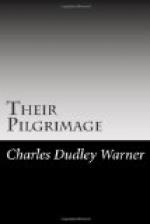life was absolutely new, and who was disposed to regard
it as peculiarly Yankee—the staid dissipation
of a serious-minded people. King, looking at it
more broadly, found this pasteboard city by the sea
one of the most interesting developments of American
life. The original nucleus was the Methodist
camp-meeting, which, in the season, brought here twenty
thousand to thirty thousand people at a time, who camped
and picnicked in a somewhat primitive style.
Gradually the people who came here ostensibly for
religious exercises made a longer and more permanent
occupation, and, without losing its ephemeral character,
the place grew and demanded more substantial accommodations.
The spot is very attractive. Although the shore
looks to the east, and does not get the prevailing
southern breeze, and the beach has little surf, both
water and air are mild, the bathing is safe and agreeable,
and the view of the illimitable sea dotted with sails
and fishing-boats is always pleasing. A crowd
begets a crowd, and soon the world’s people made
a city larger than the original one, and still more
fantastic, by the aid of paint and the jigsaw.
The tent, however, is the type of all the dwelling-houses.
The hotels, restaurants, and shops follow the usual
order of flamboyant seaside architecture. After
a time the Baptists established a camp, ground on
the bluffs on the opposite side of the inlet.
The world’s people brought in the commercial
element in the way of fancy shops for the sale of
all manner of cheap and bizarre “notions,”
and introduced the common amusements. And so,
although the camp-meetings do not begin till late
in August, this city of play-houses is occupied the
summer long. The shops and shows represent the
taste of the million, and although there is a similarity
in all these popular coast watering-places, each has
a characteristic of its own. The foreigner has
a considerable opportunity of studying family life,
whether he lounges through the narrow, sometimes circular,
streets by night, when it appears like a fairy encampment,
or by daylight, when there is no illusion. It
seems to be a point of etiquette to show as much of
the interiors as possible, and one can learn something
of cooking and bed-making and mending, and the art
of doing up the back hair. The photographer revels
here in pictorial opportunities. The pictures
of these bizarre cottages, with the family and friends
seated in front, show very serious groups. One
of the Tabernacle—a vast iron hood or dome
erected over rows of benches that will seat two or
three thousand people—represents the building
when it is packed with an audience intent upon the
preacher. Most of the faces are of a grave, severe
type, plain and good, of the sort of people ready to
die for a notion. The impression of these photographs
is that these people abandon themselves soberly to
the pleasures of the sea and of this packed, gregarious
life, and get solid enjoyment out of their recreation.
Here, as elsewhere on the coast, the greater part of the population consists of women and children, and the young ladies complain of the absence of men—and, indeed, something is desirable in society besides the superannuated and the boys in round-abouts.




